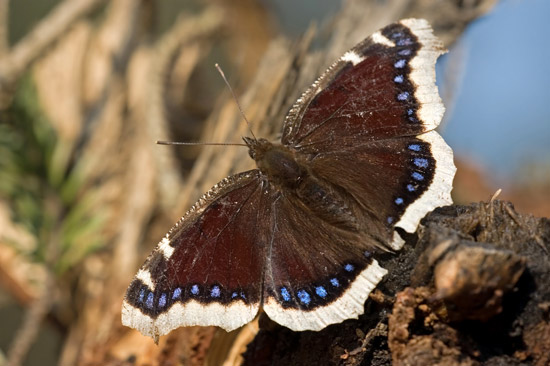Mourning Cloak Butterfly (common name)
Nymphalis antiopa (scientific name)
Overview
The mourning cloak gets its name from its dark-colored wings that resemble a traditional mourner’s dark cloak. The butterfly’s wings are of a deep reddish, dark brown, or purple color with a wide golden border on the upper side. A line of dark bright-blue spots form an inner border. Its dark color helps the mourning cloak to blend in with tree bark when it is eating or resting. Females are slightly larger than males.
Close-up
Status
Official
Physical Details
Wingspan: 2¼–4 in (5.7–10.1 cm)
Larvae: Velvety black with raised white dots, red spots, and back ridges
Lifespan
10 months
Habitat
The mourning cloak lives in fields, forests, parks, and canyons near rivers and along roads
Range: North America from northern Canada to central Mexico. Outside North America, they are found throughout Eurasia from continental Europe to Japan.
Flight period: The species usually emerges in spring, late summer, and early autumn and then overwinters as an adult. Mourning cloaks have been known to hibernate during hot summers or icy winters.
Conservation status: Least Concern
Behavior
Mourning cloak butterflies exhibit a territorial nature. They roost in high places where they will not be disturbed, make a clicking sound when approached. If disturbed, they will fly back to the same place after flying around for a minute or two. Mourning cloaks typically lay as many as 250 eggs on the branches of the host plant and when all of these caterpillars emerge they can appear to overwhelm a tree. This has earned them the nickname "spiny elm caterpillars."
Diet
Adults: Adult mourning cloaks primarily consume tree sap. They also feed on rotting fruit, animal dung, and the nectar of meadow flowers.
Larva: Leaves of poplar, willow, cottonwood, birch, hackberry, and elm trees.
Trivia
- The Nymphalis family of butterflies have tiny, brush-like front legs that earned them the name "brush-footed butterflies."
| Classification | |
|---|---|
| Kingdom: | Animalia |
| Phylum: | Arthropoda |
| Class: | Insecta |
| Order: | Lepidoptera |
| Family: | Nymphalidae |
| Tribe: | Nymphalini |
| Genus: | Nymphalis |
| Species: | N. antiopa |
Copyright © 1993-2025 World Trade Press. All rights reserved.





